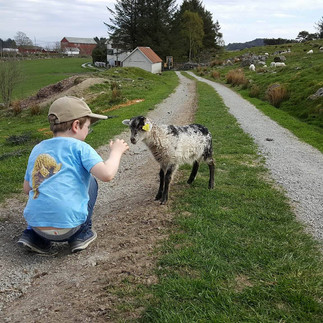Bokn
- mi5699
- 24. apr. 2022
- 3 min lesing
Oppdatert: 23. feb. 2024
The island kingdom of Bokn consists of three inhabited islands and many, small uninhabited islands. Three long bridges connect the island community to the mainland in the north, and the ferry connects Bokn to the Stavanger region in the south. Bokn has been an important place throughout the ages and its name means landmark used by seafarers.

Experiences
Bokn Church Bokn was established as a separate church parish with its own church and priest as early as the 12th century. The first Lutheran minister was assigned to Bokn, together with Skudenes, Ferkingstad and Åkra, in 1560. The first church was a stave church, which stood close to where the present church now stands, but it was replaced in 1686 by a wooden church. The present church was completed in 1847, three years before Bokn became a separate municipality. The church was designed by the architect Hans Linstow, who also designed the Royal Palace in Oslo. www.kyrkjaibokn.no Memorial stone, Asbjørn Kloster A memorial stone stands a stone’s throw east of Bokn Church, in memory of the founder of the modern temperance movement in Norway, Asbjørn Kloster (1823). The stone was erected in 1923 - on what would have been his 100th birthday.
The Sunnalandsstraumen canal. The canal that passes through Sunnaland to Karmsundet opened in 1876. This meant small vessels could avoid the exposed area of Loden when they were travelling between the sounds Karmsundet and Boknasundet.
Bokn Rural Museum The building was erected in 1908 by the Christian youth and temperance association in the community. The museum tells the history of the local youth and temperance association that was active here from 1908. The approx. 4,000 exhibits provide a good impression of what Bokn was like in bygone days. You can walk through an old kitchen, parlour and bedroom. There is also an old-fashioned shoemaker’s workshop, a schoolroom, and a fishing and agricultural department.
www.haugalandmuseene.no
Bronze Age burial mound The burial mound by Boknasundet sound dates back to the early Bronze Age 1750-1100 B.C. In 1923, a gold buckle was found that probably originates from the burial mound. The original, in the characteristic Borre style of the Viking Age, is on display at the Museum of Archaeology in Stavanger, and dates back to the 10th century. Smokehouse at Laupland The Bygdeveien road from Vatnaland to Are crosses the farm cluster at Laupland with its three generations of dwelling houses: One dating from the 16th century, one from the mid-1700s and one from the mid-1800s. Enter the smokehouse and soak up the shadowy, mysterious atmosphere of the Medieval building’s almost 500-year-old, smoke-laden walls. It has no windows and a stone floor, and is probably the oldest, secular wooden building in Haugalandet. Gamle Rasmus, probably the first crofter at Laupland after the Black Death, built the house with an open hearth in the middle of the floor and an opening in the roof for the smoke to escape through. It has now been rebuilt as a bake house with a fireplace and has been moved slightly away from the old farm cluster.
Swimming Ognahabn Ognøy, signposted bathing spot by the E39 road, Friluftsrådet Vest.
Nordre Vågholmen ‘Hummerparken’, Austre Bokn - only accessible by boat. Alvestadkroken by Boknasundet sound between Føresvik and Alvestadkroken. Community facility with sandy bottom, benches, barbecue and football pitch. Føresvik Harbour bathing spot with sandy bottom in the centre of Føresvik.
Walking areas Mount Boknafjellet 293 metres, a fantastic experience with views across the whole of Haugalandet! Klepp Fort German fort from World War II at the headland near Klepp in Loden. The remains of old bunkers, ammunition stores, trenches, the remains of canon posts, field hospital, barracks for officers and men, pigsty and checkpoint by the road. Together with Fjøløy Fort in the south and the fort at Skudeneshavn in the west, the Germans could block the approach to the Boknafjord and Karmsundet sound. The area is sign posted and easily accessible on foot and by bike. A carriage road in the outlying land makes for easy walking in the area.
Boknahåve walking trail that starts in Føresvik and goes all the way to Vestre Bokn. The trail is signposted and parking is available in Føresvik and at Bokn Church. Benches and tables have been erected several places along the trail. A round trip takes roughly four hours and is in typical coastal, heather-clad landscape. The northernmost part of the walk is defined as ‘wilderness’ in the municipal plan.
FISHING Bokn is known for its good fishing lakes for trout and eel. Bokn also has a long coastline with lots of good fishing spots.
Eating out
Café that serves open sandwiches, salads, cakes etc.
What`s on
Festivals, concerts and other cultural events are held in Bokn each year. For more information, see www.bokn.kommune.no
Tourist Information Bokn Service desk. Bokn, 5561 Bokn Open: weekdays: 8.30 - 15 Tel: +47 52 75 25 00 E-mail: post@bokn.kommune.no www.bokn.kommune.no






















Comments